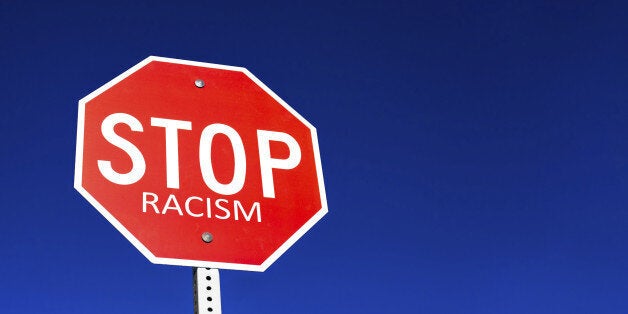
It was four years ago that I walked across the graduation stage at Dan Patch Stadium, diploma in hand.
My school, Prior Lake High School in Savage, Minnesota, was around 88% white, and while I roamed its halls my race ensured I rarely had to think about racism. I was misled by society, taught to believe that racism was only something that happened in "the South." When I got to college, though, I studied racial inequality - specifically residential segregation - in America and began to understand how deeply constitutive of my town's history white supremacy was.
Which is why it should not have surprised me to discover that a couple Prior Lake High School students tweeted a lynch threat to a black girl. Or that many others collectively and individually harassed her online with racist jeers, taunts, and memes.
It began with pictures posted featuring a group of predominantly white students wearing "dashikis": a style of shirt from West Africa. Several photos portrayed the students mocking the dashikis, as well as making confused and disgusted faces while wearing them. The students, none of whom it's fair to presume had cultural ties to West Africa, were engaging in what's known as cultural appropriation: the mishandling, belittling, or offensive use of a non-hegemonic culture by members of another (usually the dominant) culture. However, the appropriation itself is not the main event I wish to highlight, nor is my intention to demonize or blame the individual students for the insensitivity. Rather, I am horrified by what followed.
When a black student pointed out the offensive nature of the photos on Twitter, the situation went off the rails. Prior Lake High School students hurled racialized insults at the girl. The phrase "if you're not white, you're not right," appeared in the melee. One PLHS student targeted the offended student with a meme comparing black children to monkeys, a racist trope with a history spanning over a century.
Then, in a tweet eerily reminiscent of the lynching threats used by white mobs in the early to mid-twentieth century (and before) to intimidate black students from enrolling in white schools, one student tweeted a photo depicting four or five nooses with a black child looking on. Targeting the victim with such a photo, situated within the historical context of America's horrifying extrajudicial racial murders, was not merely an innocent high school prank. This appalling act was a lynching threat that should provoke a criminal investigation in addition to the student's expulsion.
The cultural appropriation and subsequent racialized harassment are important and must both be addressed. Those responsible for the heinous bullying must be held accountable and in the case of the lynching threat severely punished, if not imprisoned.
What filled these young students with such hatred and spite? The answer to this question requires a critical look not just at Prior Lake-Savage, or just at Minnesota, but rather at the way our country interprets its own past.
Our media and society often sever the links between historical events, suggesting that slavery, Native American genocide and removal, colonialism, Jim Crow, lynching, poverty, and other forms of racial violence were isolated incidents. Even these "incidents" go underground circa 1970, though. Then, so the narrative goes, once the Civil Rights Act and the Voting Rights Act had been passed, history ended. Racism presumably evaporated, leading to perfect equality in the last fifty years in the United States. Militarization of police forces, skyrocketing forced poverty, American imperial wars abroad, increasing segregation, mass incarceration, class inequality, mass deportation, and the undeniably racist War on Drugs are not given one word.
This narrative style serves a political role: to give white youth tools to uphold the systems of white supremacy that have directly and indirectly wrought unfathomable violence. Our society does not merely hide reality; it distorts it, it intentionally subverts it, and, frankly, it lies about it. It teaches students to deny that segregation, inequality, mass incarceration, and rampant racism exist by omitting them from discourse and public knowledge. It withholds tools of empathy and values of equality, which are "biased" according to white supremacist authorities whose first impulse is to cling to empty charges of "free speech" and "neutrality" rather than to protect people of color.
It was a particularly violent manifestation of this culture that turned a few sweet little white children from Scott County, MN into racist bullies who knew to draw on the violent tradition of white supremacy to cow a black girl who dared to challenge their authority to make judgments about Dashikis into submission with a lynch threat.
In the coming days it will be crucial for administrators at Prior Lake High School and law enforcement officials investigating the harassment and threats to keep in mind the role white supremacist culture played in creating environments of toxicity for high school students of color. While many if not most PLHS students would not have responded the way the white students involved in this situation did, it would be a mistake to look at this incident as an isolated one or to approach future "diversity" education without keeping a vigilant eye on the tentacles of white supremacist culture that clutch our society in a vice-grip. Any plan going forward must acknowledge and seek to counteract these social forces.
There are some things the PLHS administration can do to combat the toxic culture that bred the harassment and lynching threat: most importantly, a justice and reconciliation training for all students. To foster a sense of understanding between those of different races, students must learn about the rampant inequalities that still characterize American society. Coupled with this knowledge must be a productive, respectful dialogue on what to do to move forward. Giving students this opportunity to respect one another and arming them with facts and ideas will go a long way in combatting the never-ending ignorance and vocal hate of today's America.
